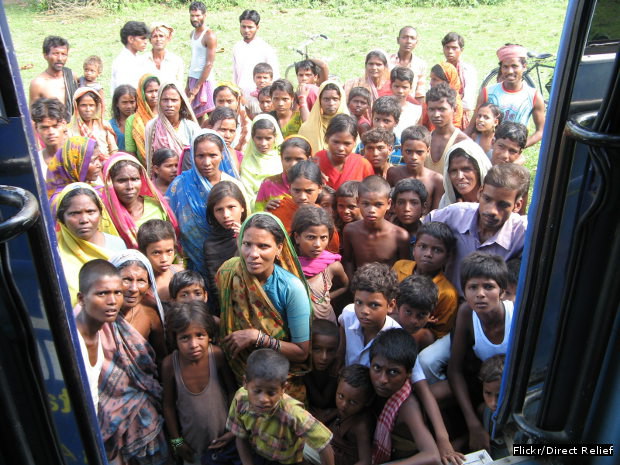Diarrhoea, Pneumonia Kill Bihar Children, But Parents Shun Award-Winning Facilities
An ambitious $23-million (Rs 153.5 crore), award-winning five-year-old programme funded by the Bill and Melinda Gates Foundation to arrest childhood diarrhoea and pneumonia in Bihar--a state with India's sixth highest mortality rate of children under five--has had little impact on disease prevalence or treatment, according to an evaluation by researchers from Duke and Stanford universities in the USA and the University College of London.
The evaluation--which the global advocacy running the programme says was incomplete--indicates that parents in rural Bihar, a state with some of India's worst general health indicators, as IndiaSpend reported in August 2015, would only pay for services unavailable locally, preferring to otherwise visit unqualified practitioners, perhaps not recognising that diarrhoea and pneumonia were life-threatening.
Less than 3% of children with diarrhoea and pneumonia visited medical professionals from the World Health Partners (WHP) Sky Program, which trains thousands of informal health providers and connects them to patients by telemedicine--the remote diagnosis and treatment of patients using voice, video and data links--to create a network of franchisees to more effectively treat diarrhoea and pneumonia, the leading killers of children under five in Bihar.
“There are a number of likely reasons why the program failed to have an impact,” said Manoj Mohanan, assistant professor of public policy and economics at Duke University’s Sanford School of Public Policy and co-author of the evaluation published in the October 2016 issue of Health Affairs, a global health-policy journal. “Most importantly, the business model was based on untested assumptions about demand--not only practitioners’ willingness to pay to join the network, but also the level of demand for care provided by members in the network.”
WHP, an international health advocacy, responded that the evaluation was completed in December 2014, when the programme had completed only two of its five years. WHP Country Director Prachi Shukla said similar projects addressing tuberculosis, ante-natal care and family planning in Rajasthan and Bihar were working successfully.
“The larger conclusion for us and for persons looking at ways of using technologies and management systems to deliver care to rural community is this: For curative services that are considered simple such as diarrhoea and pneumonia, the rural community is quite happy with what they get locally and are not willing to access from city doctors at higher prices. But for some other services which the rural providers don’t offer, the community is willing to pay more,” Shukla told IndiaSpend over email.
Childhood diarrhoea and pneumonia are preventable and treatable, but they killed about 300,000 children under five in India in 2015, the world's highest such death toll, according to this John Hopkins Bloomberg School of Public Health report. Up to 10.7% of children in rural Bihar suffered from diarrhoea and 6.8% suffered from acute respiratory illnesses two weeks before the survey, according to data from the National Family Health Survey, 2015-16.
On its website, WHP said it had engaged 10,000 rural medical practitioners in the Sky programme and had treated 2.7 million children with diarrhoea and 4.1 million with pneumonia. The programme got global recognition at the 2013 World Economic Forum and was given the Schwab Foundation Award, 2013, Skoll Award 2013, and 2015 Asian Award.
Less than one in four parents visited a medical doctor
The Health Affairs evaluation found that no more than 2.9% of children with diarrhoea and 2.7% of children with symptoms of pneumonia went to WHP Sky providers. About 40% parents took children to informal providers; 37.7% of children with diarrhoea and 42.7% children with pneumonia were taken to MBBS doctors. Others sought medical help from pharmacists (12.2% for diarrhoea, 8% for pneumonia), government providers (3.6% for diarrhoea, 4.4% for pneumonia), AYUSH (Ayurveda, Yoga, Naturopathy, Unani, Siddha and Homeopathy) practitioners (3.3% for diarrhoea, 1.9% for pneumonia) and auxiliary nurse midwifes (ANM)/ accredited social health activists (ASHA)/ Anganwadi workers (AWW) (0.2% for diarrhoea, 0.2% for pneumonia).
Who Do Bihar's Parents Visit For Childhood Diarrhoea and Pneumonia?
Source: Evaluation by researchers at Duke University, Stanford University and University College of London
They also found there was “overall no significant” improvement in the children receiving care for either diarrhoea or pneumonia through the program.
“Future efforts in social franchising that aim to deliver higher quality health care services might want to first rigorously test their assumptions about demand among potential franchisees, and the patients’ willingness to pay for improvements in quality of services provided,” added Mohanan.
The Duke, Stanford and University College of London researchers collected data on 36,315 randomly selected children aged under five in 2011 and 31,635 children in 2014, before and after the program was implemented. Researchers compared changes between 2011 and 2014 in 153 areas where the program was implemented with changes in 207 similar areas where the program was not implemented.
These findings are also relevant to the telemedicine market, expected to reach Rs 200 crore by 2020, according this 2016 report by the Associated Chambers of Commerce of India. The government also launched the National Telemedicine Network in 2016 to provide healthcare to remote locations by upgrading government healthcare facilities nationwide.
Update: The story has been updated to clarify that the figures from the National Family Health Survey, 2015-16, are for rural Bihar.
(Yadavar is principal correspondent with IndiaSpend.)
We welcome feedback. Please write to respond@indiaspend.org. We reserve the right to edit responses for language and grammar.
__________________________________________________________________
“Liked this story? Indiaspend.org is a non-profit, and we depend on readers like you to drive our public-interest journalism efforts. Donate Rs 500; Rs 1,000, Rs 2,000.”



